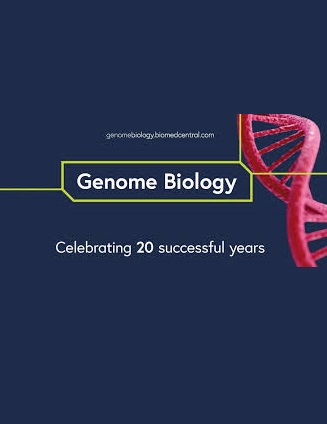Annelid methylomes reveal ancestral developmental and aging-associated epigenetic erosion across Bilateria
IF 10.1
1区 生物学
Q1 BIOTECHNOLOGY & APPLIED MICROBIOLOGY
引用次数: 0
Abstract
DNA methylation in the form of 5-methylcytosine (5mC) is the most abundant base modification in animals. However, 5mC levels vary widely across taxa. While vertebrate genomes are hypermethylated, in most invertebrates, 5mC concentrates on constantly and highly transcribed genes (gene body methylation; GbM) and, in some species, on transposable elements (TEs), a pattern known as “mosaic”. Yet, the role and developmental dynamics of 5mC and how these explain interspecies differences in DNA methylation patterns remain poorly understood, especially in Spiralia, a large clade of invertebrates comprising nearly half of the animal phyla. Here, we generate base-resolution methylomes for three species with distinct genomic features and phylogenetic positions in Annelida, a major spiralian phylum. All possible 5mC patterns occur in annelids, from typical invertebrate intermediate levels in a mosaic distribution to hypermethylation and methylation loss. GbM is common to annelids with 5mC, and methylation differences across species are explained by taxon-specific transcriptional dynamics or the presence of intronic TEs. Notably, the link between GbM and transcription decays during development, alongside a gradual and global, age-dependent demethylation in adult stages. Additionally, reducing 5mC levels with cytidine analogs during early development impairs normal embryogenesis and reactivates TEs in the annelid Owenia fusiformis. Our study indicates that global epigenetic erosion during development and aging is an ancestral feature of bilateral animals. However, the tight link between transcription and gene body methylation is likely more important in early embryonic stages, and 5mC-mediated TE silencing probably emerged convergently across animal lineages.蛛形纲甲基组揭示了双尾目动物祖先发育和衰老相关的表观遗传侵蚀过程
以 5-甲基胞嘧啶(5mC)形式存在的 DNA 甲基化是动物体内最丰富的碱基修饰。然而,不同类群的 5mC 水平差异很大。脊椎动物基因组的甲基化水平很高,而在大多数无脊椎动物中,5mC 主要集中在持续和高度转录的基因上(基因体甲基化;GbM),在某些物种中,5mC 还集中在转座元件(TE)上,这种模式被称为 "马赛克"。然而,人们对 5mC 的作用和发育动态以及它们如何解释 DNA 甲基化模式的种间差异仍然知之甚少,尤其是在无脊椎动物的一个大支系--螺旋纲中,该支系占动物门类的近一半。在这里,我们为螺旋纲中具有不同基因组特征和系统发育位置的三个物种生成了基本分辨率的甲基组。所有可能的 5mC 模式都出现在环节动物中,从典型的无脊椎动物中间水平的镶嵌分布到高甲基化和甲基化缺失。GbM是环带动物中常见的5mC,而不同物种之间的甲基化差异可通过类群特异的转录动态或内含子TE的存在来解释。值得注意的是,GbM 与转录之间的联系在发育过程中逐渐减弱,同时在成体阶段会出现逐渐的、全面的、依赖于年龄的去甲基化。此外,在早期发育过程中,用胞苷类似物降低 5mC 水平会损害正常的胚胎发生,并重新激活环带藻 Owenia fusiformis 中的 TEs。我们的研究表明,发育和衰老过程中的整体表观遗传侵蚀是双侧动物的祖先特征。然而,转录与基因体甲基化之间的紧密联系在早期胚胎阶段可能更为重要,5mC介导的TE沉默可能是动物各系之间趋同出现的。
本文章由计算机程序翻译,如有差异,请以英文原文为准。
求助全文
约1分钟内获得全文
求助全文
来源期刊

Genome Biology
Biochemistry, Genetics and Molecular Biology-Genetics
CiteScore
21.00
自引率
3.30%
发文量
241
审稿时长
2 months
期刊介绍:
Genome Biology stands as a premier platform for exceptional research across all domains of biology and biomedicine, explored through a genomic and post-genomic lens.
With an impressive impact factor of 12.3 (2022),* the journal secures its position as the 3rd-ranked research journal in the Genetics and Heredity category and the 2nd-ranked research journal in the Biotechnology and Applied Microbiology category by Thomson Reuters. Notably, Genome Biology holds the distinction of being the highest-ranked open-access journal in this category.
Our dedicated team of highly trained in-house Editors collaborates closely with our esteemed Editorial Board of international experts, ensuring the journal remains on the forefront of scientific advances and community standards. Regular engagement with researchers at conferences and institute visits underscores our commitment to staying abreast of the latest developments in the field.
 求助内容:
求助内容: 应助结果提醒方式:
应助结果提醒方式:


